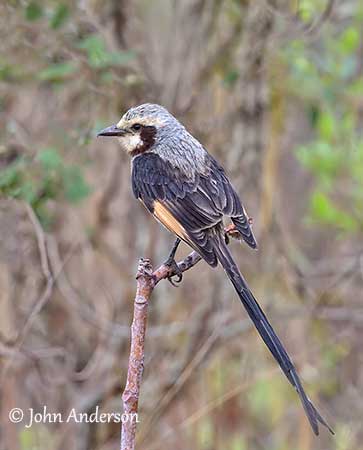




Fr: Moucherolle yétapa
Ang: Streamer-tailed Tyrant
All: Kehlband-Schleppentyrann
Esp: Yetapá Grande
Ita: Tiranno vessillario
Nd: Lintstaarttiran
Sd: serpentinstjärtstyrann
Photographers:
John Anderson
John Anderson Photo Galleries
Jean Michel Fenerole
Photos d’Oiseaux du monde
Ken Havard
My Bird Gallery & Flickr gallery 1 & Flickr gallery 2
William Price
PBase-tereksandpiper & Flickr William Price
Text by Nicole Bouglouan
Sources:
HANDBOOK OF THE BIRDS OF THE WORLD Vol 9 - by Josep del Hoyo - Andrew Elliot - David Christie - Lynx Edicions - ISBN: 8487334695
Neotropical Birds – Cornell Lab of Ornithology
Arthur Grosset's Birds (Arthur Grosset)
Academia - First record of Streamer- tailed Tyrant Gubernetes yetapa in Uruguay
Wikipedia, la enciclopedia libre
Streamer-tailed Tyrant
Gubernetes yetapa
Passeriformes Order – Tyrannidae Family
INTRODUCTION:
The Streamer-tailed Tyrant of the subfamily Fluvicolinae in the huge family Tyrannidae is a large tyrant of open country. It is one of the most spectacular of this family and the only member of the genus Gubernetes. This species is known for its elaborate courtship displays and duets between mates.
The Streamer-tailed Tyrant is found in Brazil, Bolivia, Paraguay and N Argentina, where it frequents damp grasslands and marshes near streams. But it also needs nearby bushes and shrubs used as perches for hunting and singing. It nests in a cup-shaped structure usually built in clump of grass, and both adults share most of nesting duties.
The species is described as uncommon and patchily distributed, but it is not globally threatened for the moment.
DESCRIPTION OF THE BIRD:
Biometrics:
Length: 35-38 cm (42 cm with the tail)
The Streamer-tailed Tyrant adult male has pale grey upperparts with dark brown shaft streaks. The upperwing is blackish with conspicuous rufous patch at base of primaries well visible in flight. The tertials show pale brown edges. The very long, graduated, blackish tail is deeply forked.

On the underparts, chin and throat are white, the latter outlined by a dark chestnut pectoral collar extending on to the neck sides. Breast and body sides are pale grey with indistinct, dark shaft streaks. Belly and undertail-coverts are mostly white. The underwing is white with greyish flight-feathers.
On the head, forecrown, crown and nape are pale grey with dark, narrow streaks. The supercilium is whitish, the lores are dark grey and the cheeks are white.
The stout bill is black. The eyes are dark brown. Legs and feet are black.
The adult female is smaller. The tail is shorter and the plumage is slightly duller.
Her size is about 35 centimetres with the tail.
The juvenile is much duller with brown blotches on the upperparts. The tail is much shorter too.
RANGE:
The Streamer-tailed Tyrant is found in NW Bolivia (upper Río Beni) and SC Brazil (S Mato Grosso, extreme S Bahia, and S to W Río Grande do Sul), S to E Paraguay and NE Argentina (in Choco, Corrientes and Misiones provinces).
HABITAT:
The Streamer-tailed Tyrant frequents plantations of Buriti palms that grow on wet areas like swamps, and also seasonally wet grasslands usually near streams, up to 1,100 metres of elevation.
But it needs some bushes and shrubs used as perches for hunting and singing.
CALLS AND SONGS: SOUNDS BY XENO-CANTO
The Streamer-tailed Tyrant gives loud calls that attract attention. The most notable vocalisation is a harsh “whee-irt” or “wiirt” repeated several times, and given by the bird hovering over its foraging areas. We can also hear a descending phrase “jew-jew-jew”.
The dawn song is given from a perch. Duets between mates are common during the courtship displays, including piercing whistles and warbles. They also produce “bill-popping” sounds.
BEHAVIOUR IN THE WILD:
The Streamer-tailed Tyrant has large, stout bill allowing it to catch large insects, often on the wing. But it also hunts from perch, sallying out often over long distances to catch a prey.
It usually forages by flying low over marshes or at the edge of forest galleries. It may sometimes pounce to the ground or sally downwards to catch insects from the vegetation.
The social system of this species is usually the monogamous pair-bond. The nest is an open cup placed in clump of grass in marshy area. The adults defend a large territory. They can be seen in family groups of 4-5 individuals.

The courtship displays of the Streamer-tailed Tyrant are spectacular and duets between mates are common. Male and female are perched together on exposed shrub or bush. Either they face each other, or they are turned in opposite directions. They produce piercing whistles and warbles, but also “bill-popping” sounds. They raise and flap the wings. The tail is also raised and fanned, and they low and raise their heads alternately. They are usually perched between 10 and 50 centimetres apart.
The Streamer-tailed Tyrant is resident.
When the bird is flying over long distances, the long tail is often whipping behind. But it is very agile when hunting.

REPRODUCTION OF THIS SPECIES:
The breeding season takes place between October and January in Brazil.
The nest of the Streamer-tailed Tyrant is an open cup built in the middle of a clump of grass, about 80 centimetres above the ground within a marshy area.
The outer part is made with thick grass stems, whereas the inner part is lined with rootlets, finer grass stems and bits of snake skin. It is about 15 centimetres in diameter.
The nest observed contained 3 white, oval shaped eggs.
Fledglings were recorded in November-January (mainly mid-December).

PROTECTION / THREATS / STATUS:
The Streamer-tailed Tyrant is generally uncommon to locally common, especially in protected areas throughout the range. It is usually patchily distributed.
The size of the population is unknown, but it is suspected to be stable in the absence of substantial threats.
The species is not globally threatened, and the Streamer-tailed Tyrant is currently evaluated as Least Concern.